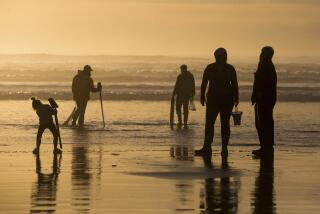Sea Farmers : Partners Lease Lagoon Acreage to Turn Little Shellfish Into Big
CARLSBAD â Dick Glenn and Jim McBeth are a couple of farmers who wouldnât know one end of a cow from the other. But, come January or so, they will begin harvesting one of the tastiest crops this side of Morro Bay.
Glenn and McBeth are sea farmers who have leased a five-acre piece of underwater real estate in the Agua Hedionda Lagoon to raise millions of oysters and mussels and, maybe later, clams. The profit comes from growing big ones out of little ones, and the payoff is just a month or so away.
In their small portion of the outer lagoon, they are tending nurseries, hatcheries and purifying beds, plus a dozen other operations just to be sure that their shellfish will be the tastiest, the freshest and the hardiest specimens in Southern California.
Success and the prospect of a 200-ton annual harvest in a year or so didnât come easy. Not only did the partners in Seafarms West have to contrive, invent and import much of their equipment, they also had to find outlets for their produce once the harvests are in.
Ollieâs Oyster Bar in Carlsbad got in on the ground floor, but it opened too soon to serve Seafarmsâ first crop of home-grown mussels and clams. So the company is importing and purifying oysters for the restaurantâs first couple of weeks until the local harvest comes in.
The operation is not exactly a cerebral pursuit, Glenn admits. Both partners, who hold doctoral degrees, agree that itâs boring. All you do is plant the shellfish below the saltwater lagoonâs tidal level--a tough and smelly job--and wait. Then, about a year later, Glenn said, you go back out and harvest them.
The Seafarms West fleet consists of one clumsy barge, designed and built by the partners to do most of the dirty work of sea farming. An outboard motor powers the craft out to the shellfish beds and an electric winch lifts out the plastic âstockingsâ that house the maturing mussels and deposits them back into their element after a look-see.
The sea farmers have gone to great pains to protect the tiny oysters from predators--chiefly marine snails called drills--which âcould wipe us out; they are voracious,â McBeth said. Oyster drills can bore through a mollusk shell and devour the meat inside unless the shellfish are protected by latticed plastic trays and tubes.
To protect the shellfish against poachers, Glenn and McBeth are keeping mum about the exact location of their sea farm and are counting on their landlord, San Diego Gas & Electric, to furnish security from human marauders.
Soon, however, the secret will be out because the partners are planning to open a roadside stand to peddle their fresh wares along Carlsbad Boulevard near SDG&E;âs Encina power plant.
âI figure we have a huge market area, all the way from the border up into Los Angeles,â Glenn said. âWeâll be the only ones. Nobody else around here is crazy enough to try this.â
More to Read
Sign up for Essential California
The most important California stories and recommendations in your inbox every morning.
You may occasionally receive promotional content from the Los Angeles Times.










